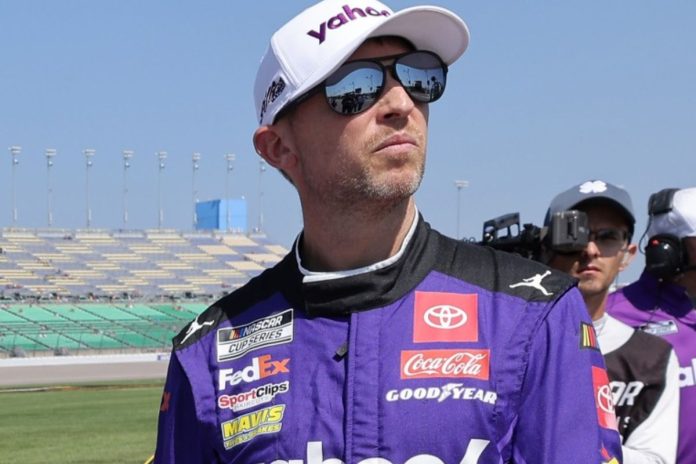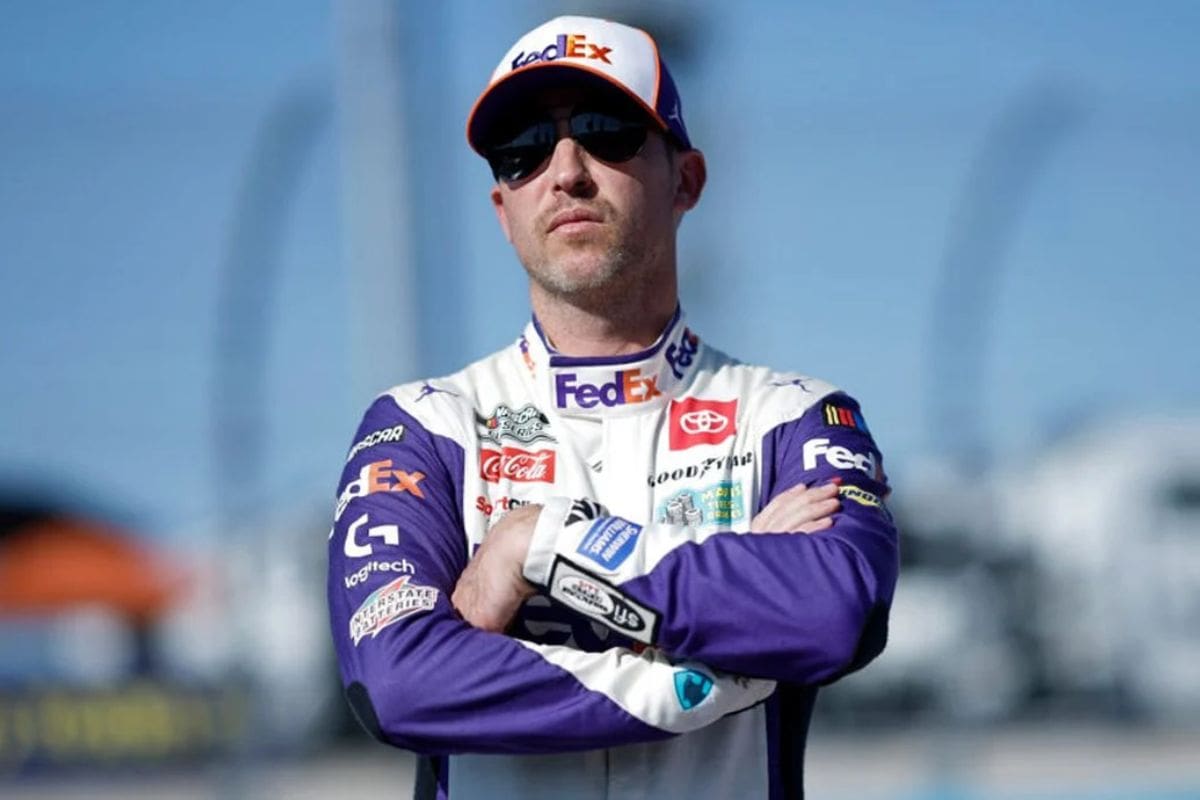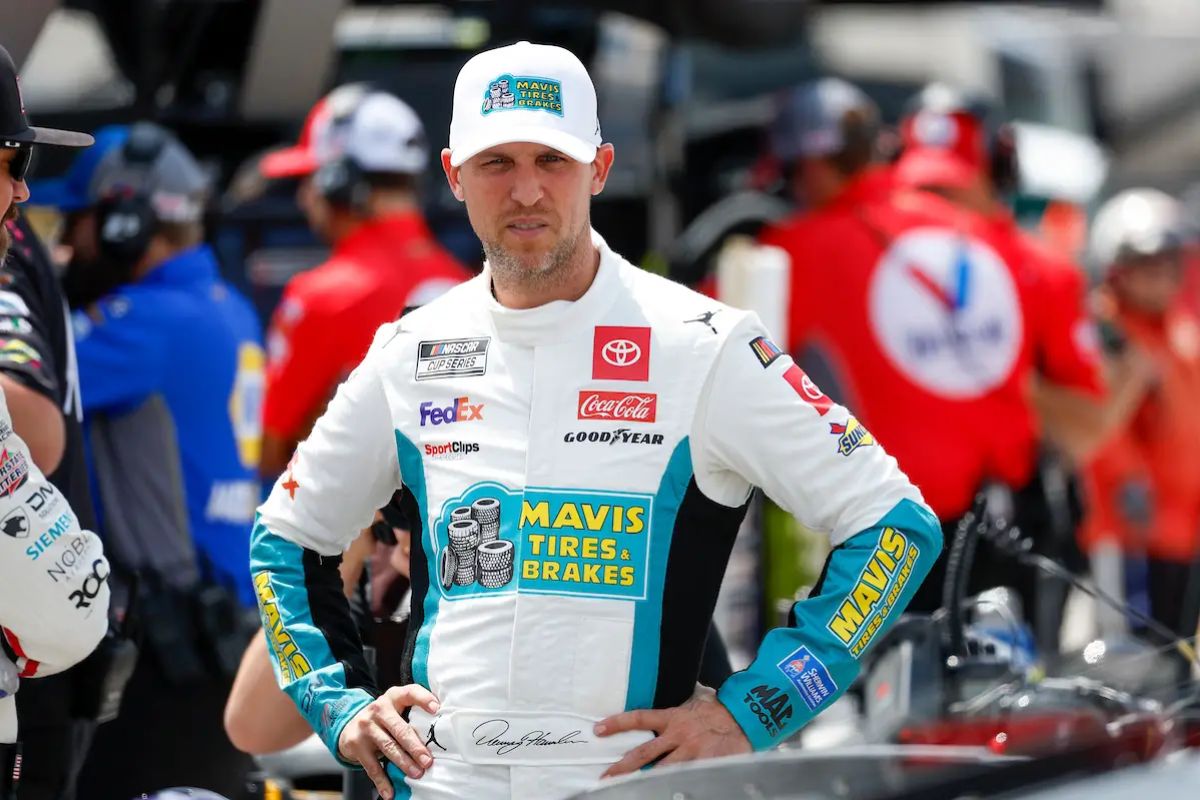Denny Hamlin Slams NASCAR: Denny Hamlin’s recent public criticism of the changes at Texas Motor Speedway, Texas started a broader discussion on the balance between innovation and tradition in NASCAR. His pointed disapproval of the removal of the iconic scoring pylon that has long enhanced both spectator experience and driver strategy. Raises important questions about consequences of such changes.
Key Takeaways
- Denny Hamlin criticized the recent modifications at Texas Motor Speedway, particularly the removal of the iconic scoring pylon.
- He expressed concerns about the traditional elements integral to the race’s character and history.
- Hamlin questioned the motivations behind the track changes, implying potential impacts on race strategies and integrity.
- The alterations could affect real-time race standings updates, complicating strategies for drivers and bettors.
Denny Hamlin’s Critique of Texas Motor Speedway Changes
Denny Hamlin expressed his discontent regarding the recent modifications at Texas Motor Speedway, particularly criticizing the decision to remove the iconic scoring pylon. His frustration highlights a broader concern among racing professionals and enthusiasts about the gradual removal of traditional elements that many believe are the spirit and history of motorsports venues.
“After I wrecked, I first of all I was looking for the scoring Tower to see who was running where couldn’t find the damn thing they took it out,”
“So, Bristol we used to have we used to have so they have the big video thing right but then they used to have a video like a round video board on the bottom of the that Center piece that would have the like a ticker the ticker of the of who’s running where.”-Hamlin
The scoring pylon, much more than a structural feature, served as a symbol of continuity and identity for Texas Motor Speedway. Its removal represents a significant shift in the track’s visual and cultural imprint, potentially altering its unique environment that has historically enhanced the spectator experience.
Furthermore, Hamlin’s comparison of these changes to similar modifications at other tracks raises questions about the underlying motivations for such decisions. This tension highlights a key challenge facing track owners and regulators: maintaining the integrity and heritage of the venues while adapting to evolving demands of safety, technology, and fan engagement.
Impact on Race Dynamics and Betting Speculations
How might the removal of the scoring pylon at Texas Motor Speedway influence race dynamics and fuel speculations in betting circles? This seemingly minor alteration has the potential to have a substantial impact on the race environment, affecting both drivers and viewers. Drivers, traditionally reliant on the scoring pylon for real-time updates on their standings during the race, now face a new challenge.
“Now you only see like the top eight. And then uh we also had video boards up on the Suites at Bristol they took those out. Watkins Glenn we took out the scoreboard on the front STP um I I can’t make sense of why they’re taking out scoring pylons at these tracks well.”-Hamlin
This alteration can also obscure the clarity of race dynamics for spectators and viewers. The scoring pylon’s absence means that information, which was once instantly accessible, now requires digital tools or other means to track. The uncertainty introduced might lead to more volatile betting lines, as gamblers speculate on positions and outcomes based on less immediate data.
Jared Allen’s theory linking the removal of billboards to the rise of legal gambling introduces an additional layer of complexity. If true, this suggests a strategic manipulation of visual cues within the race environment, potentially designed to influence betting behaviors.
Chase Elliott’s Breakthrough Victory
Chase Elliott’s recent victory in Autotrader EchoPark Automotive 400 at Texas Motor Speedway marked a significant milestone, ending a challenging 42-race winless streak and reviving his racing season. The impact of this win extends beyond a mere race win; it signifies a critical turnaround in Elliott’s career course, potentially re-establishing him as a strong contender in the NASCAR series.
Denny Hamlin, a seasoned driver himself, recognized the profound effect of Elliott’s victory, commenting on the renewed confidence it brought into Elliott’s campaign. The win effectively removes the doubt and the inquiries regarding when Elliott would return to the winner’s circle.
“It certainly is I think it’ll be big I mean I talked about the confidence aspect of but just the the monkey off the back yes! You don’t have to answer the questions of well when are you going to win it’s been over a year now. Like the clock resets so certainly he, you know, you buy some time there,”-Hamlin
Reflections on Sponsorship and Racing Success
Reflecting on the interconnected relationship between racers and their sponsors, Hamlin emphasizes the vital role that sponsorship plays in the world of NASCAR, particularly highlighting how Elliott’s commitment to Hooters was instrumental in achieving his recent racing success. The dynamics of such partnerships often determine not only the financial health of a racing team but also influence its competitive strategies and outcomes.
Personal Reflections and Future Prospects
Hamlin’s acknowledgment of Chase Elliott’s recent victory exemplifies his recognition of shifting paradigms within NASCAR’s competitive landscape. By appreciating Elliott’s success, Hamlin highlights the importance of morale and momentum in racing accomplishments, elements he likely aims to utilize in revive his own career. This perspective emphasizes his readiness to leverage new opportunities and challenges for personal and professional growth.
Looking ahead, Hamlin’s future prospects seem related to his ability to adapt to continuous changes in the racing environment and his capacity for strategic foresight. His seasoned experience combined with a proactive outlook positions him well to navigate the complexities of modern NASCAR racing. The upcoming seasons may very well see Hamlin not only reclaiming his top form but also influencing newer standards in race strategy and competition.
News in Brief: Denny Hamlin Slams NASCAR
Denny Hamlin’s criticism of the modifications at Texas Motor Speedway highlights the tension between modernization and the preservation of tradition within NASCAR. These changes not only impact the race dynamics but also influence betting speculations and the overall spectator experience.
Such developments call for a careful consideration of how alterations can affect the heritage and future of the sport, emphasizing the need for a balanced approach to evolution in NASCAR environments.
Our Reader’s Queries
Q. When did Denny Hamlin start driving for Joe Gibbs Racing?
A. Making his NASCAR Cup Series debut in 2005 at Kansas Speedway with JGR, Hamlin acknowledges J.D. Gibbs for granting him his initial opportunity at Joe Gibbs Racing. Reflecting on the pivotal moment in a 2017 Twitter video, Hamlin expressed gratitude, stating, “He’s the one who actually gave me my first opportunity with Joe Gibbs Racing.
Q. Has Denny Hamlin ever won a road race?
A. Hamlin secured his first road course victory of his career by leading just 10 laps out of the 90-lap race, but they proved to be the most crucial ones, especially at the finish line.
Q. Who drives for Denny Hamlin?
A. Denny Hamlin finds himself in a unique position among NASCAR Cup Series drivers. Despite maintaining his role as a driver for Joe Gibbs Racing throughout his career, he also holds a stake as part-owner of 23XI Racing alongside NBA icon Michael Jordan. The team’s roster includes drivers Bubba Wallace and Tyler Reddick.
ALSO READ: Denny Hamlin Avoids Criticizing Texas Speedway: Inside His Silence





